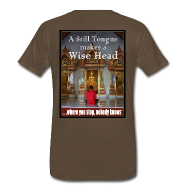
While doing walking meditation in a park that I learned while being a novice, something came to me. As I said to a friend, “All it is ...is deliberately and consciously being aware of every single movement...so it will transfer in time to everything you do. Leading to a keener mental awareness of every thing we do, from talking to our actions. So you can see in advance how your actions or speech will affect those around you. And thus, hopefully wisdom. Most of the time, they do it walking, then standing and seated last, a natural progression to quiet the mind down.” This mindfulness is at the heart of Thai Buddhism.

What I saw at the Wat where I resided, school kids coming for dhamma lessons, meditation, along with Pali. I saw families join them in back, or help with food. I saw new monks being ordained, and the sangha feeding the monks. I witnessed a lot of what comprises Thai Buddhism, and started to form a real understanding of why the language is also based on Buddha’s teachings. And how most everything is formed by this exposure in Thai’s day-to-day life. It just clicked. I had just a small taste, but at least now I feel I know a little more of my partner’s internal existence. I know I way far from knowing it all, but even this one experience has helped me understand a little bit more. Impermanence has shaped their lives along with wisdom from respected monks. Mindfulness is at the heart of it all and leads to more patience. I would become a novice again for longer time frame. This has also helped to quash my previous idea that Buddhism here is more about the rituals, which it is not. That offerings are based on merit and also have the unique capacity to help cut-down on our self-cherishing. I have gone four times to meditate during the day at various Wat’s that have spaces designated for this, some with ongoing dhamma talks, some just silent. Maybe I can learn all the Pali chants.































